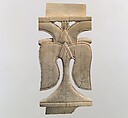Openwork furniture plaque with leaves
Not on view
During the early first millennium B.C., ivory carving was one of the major luxury arts that flourished throughout the ancient Near East. Elephant tusks were carved into small decorative objects such as cosmetic boxes and plaques used to adorn wooden furniture. Gold foil, paint, and semiprecious stone and glass inlay embellishments enlivened these magnificent works of art. Based on certain stylistic, formal, and technical characteristics also visible in other media, scholars have distinguished several coherent style groups of ivory carving that belong to different regional traditions including Assyrian, Phoenician, North Syrian and South Syrian (the latter also known as Intermediate).
Several ivories in the Metropolitan Museum’s collection are from the Aramaean town of Arslan Tash, ancient Hadatu, in northern Syria just east of the Euphrates River, close to the modern Turkish border. French archaeological excavations at the site in 1928 revealed city walls and gates in addition to a palace and temple that were built when the Neo-Assyrian king Tiglath-Pileser III (744-721 B.C.) turned the town into a provincial capital and military outpost. During the excavations, over one hundred ivory furniture inlays that can be attributed to the South Syrian and Phoenician styles were found in a building near the palace. One piece bears a dedicatory inscription in Aramaic to King Hazael, mentioned in the Bible, who ruled Damascus during the second half of the 9th century (ca. 843-806 B.C.), suggesting that this collection of ivory furniture inlays could have been taken by the Assyrian state as tribute or booty from Damascus. The Arslan Tash ivories share an amalgamation of Egyptianizing motifs typical of the Phoenician style and forms characteristic of North Syrian art that may indicate a South Syrian or Damascene origin of this group. Today, these ivories are housed in museums in Paris, Aleppo, Jerusalem, Karlsruhe, and Hamburg, as well as The Metropolitan Museum of Art.
Set within a thin frame at the upper and lower edges of this openwork plaque, two sets of successively unfolding leaves outlined with raised ribs grow out of a thin stalk that contrasts with its wide base. Triangular junctures detailed with incised lines join each leaf, from which sprout other floral elements. The openwork technique and elegant forms are characteristic of the Phoenician style. The tenons preserved above and below the upper and lower edges would have been slotted into another furniture element, perhaps a frame. There is a West Semitic letter inscribed into the back of the upper tenon, probably as a guide for assembly. The absence of vertical frame elements suggests that plaques with this theme were placed side by side to form a continuous floral frieze. Another openwork plaque with a similar motif in the Metropolitan Museum’s collection was found at the Neo-Assyrian capital of Nimrud (MMA 58.31.10).
Due to rights restrictions, this image cannot be enlarged, viewed at full screen, or downloaded.

